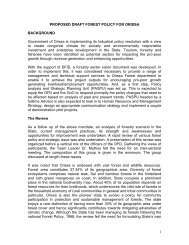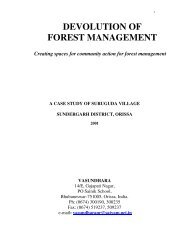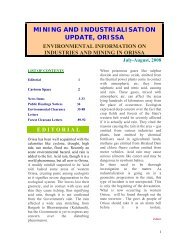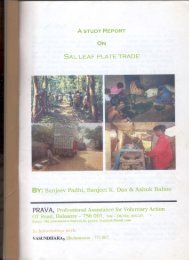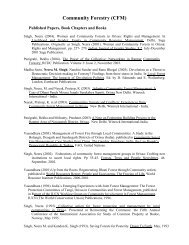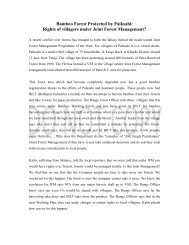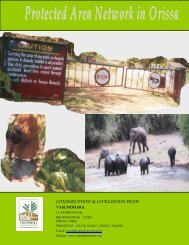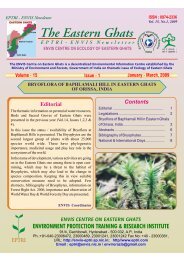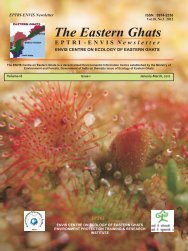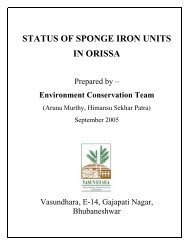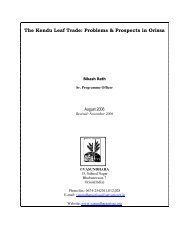Bamboo in Orissa: Trade and Livelihood Perspective - Vasundhara
Bamboo in Orissa: Trade and Livelihood Perspective - Vasundhara
Bamboo in Orissa: Trade and Livelihood Perspective - Vasundhara
You also want an ePaper? Increase the reach of your titles
YUMPU automatically turns print PDFs into web optimized ePapers that Google loves.
All rights reserved by VASUNDHARA(www.vasundharaorissa.org). For any clarification, contact author at sunlit1968@yahoo.co.<strong>in</strong><br />
other areas <strong>in</strong> search of some other work, <strong>and</strong> the rest either starved at home or managed<br />
somehow.<br />
Naxalite areas<br />
The untapped potentiality of Malkangiri area is said to be around 80000 SUs. To follow the<br />
procedure used above, this would mean 1142857.1 m<strong>and</strong>ays. However, given the<br />
controversy over this assessment it would be safe for now to consider 25% of this projected<br />
figure.<br />
Accord<strong>in</strong>g to Bakshipatra, the number of cutters <strong>in</strong> the Malkangiri belt was around 3000-<br />
4000, <strong>and</strong> <strong>in</strong> the Gudari belt around 10000(per comm..). That means about 14000 cutters<br />
lost their job so far their own area is concerned. While this assessment is yet to be<br />
confirmed, the unemployment thus generated is claimed to have severely aggravated the<br />
naxalite situation.<br />
Ideally speak<strong>in</strong>g, cutt<strong>in</strong>g operations provide employment to the cutters for seven months<br />
i.e., from October to June. However, the operation may be over with<strong>in</strong> a lesser period <strong>and</strong><br />
the opportunity reduces accord<strong>in</strong>gly.<br />
On an average, the cutters depended on bamboo cutt<strong>in</strong>g operations for six to eight months,<br />
for their livelihood. After June, when the operations were over, they could work as<br />
agricultural labourers for next few months; but bamboo cutt<strong>in</strong>g earned them about 60 to<br />
70% of their total annual <strong>in</strong>come. Hence, bamboo cutt<strong>in</strong>g was their chief profession. For<br />
people liv<strong>in</strong>g near the stockyards or godowns, work is often available even after the<br />
operation is over because jobs like re-bundl<strong>in</strong>g <strong>and</strong> truck-load<strong>in</strong>g are available there <strong>and</strong><br />
the cutters' family takes its advantage.<br />
This profession had double advantage for them, i.e., cash <strong>in</strong>come <strong>and</strong> <strong>in</strong>come <strong>in</strong> k<strong>in</strong>d. The<br />
<strong>in</strong>come <strong>in</strong> k<strong>in</strong>d was actually a subsidized food supply under the World Food Programme<br />
<strong>in</strong> the follow<strong>in</strong>g manner(per work<strong>in</strong>g day or food day per person):<br />
Rice-2 kg<br />
Dal-200 grams<br />
Cook<strong>in</strong>g oil-200 grams<br />
One food day means the cutter is eligible to get a supply of one food unit. Total<br />
cost(subsidized) of food units <strong>in</strong> a work<strong>in</strong>g week/month is accord<strong>in</strong>gly deducted from the<br />
cutter's wage.<br />
55



